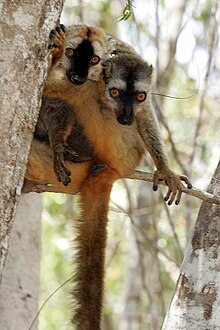bio.wikisort.org - Animal
The red-fronted lemur (Eulemur rufifrons), also known as the red-fronted brown lemur or southern red-fronted brown lemur, is a species of lemur from Madagascar. Until 2001, it was considered a subspecies of the common brown lemur, E. fulvus.[4] In 2001, E. fulvus was split into several separate species, including Eulemur rufus, in which this species was included. In 2008, E. rufus was split into two species, the red lemur (E. rufus) and the red-fronted lemur (E. rufifrons).[3] E. rufus covers the population on the west coast north of the Tsiribihina River and E. rufifrons covers the population on the west coast south of the Tsiribihina River and the population in eastern Madagascar.[3] The species split was based on genetic and morphological evidence.[3] Mitochondrial DNA analysis indicates that E. rufifrons may be more closely related to the common brown lemur (E. fulvus), white-headed lemur (E. albifrons) and Sanford's brown lemur (E. sanfordi) than it is to E. rufus.[3]

| Red-fronted lemur | |
|---|---|
 | |
 | |
Conservation status | |
CITES Appendix I (CITES)[2] | |
| Scientific classification | |
| Kingdom: | Animalia |
| Phylum: | Chordata |
| Class: | Mammalia |
| Order: | Primates |
| Suborder: | Strepsirrhini |
| Family: | Lemuridae |
| Genus: | Eulemur |
| Species: | E. rufifrons |
| Binomial name | |
| Eulemur rufifrons | |
 | |
| Distribution of E. rufifrons[1] | |
The red-fronted lemur lives on the western coast of Madagascar between the Tsiribihina River to the north and south of the Fiheranana River and in eastern Madagascar from the Mangoro River and Onive River to the Andringitra Massif.[3] It lives in dry lowland forests.[5] It has a head and body length of 35 to 48 centimetres (14 to 19 in) and with a 45 to 55 centimetres (18 to 22 in) tail.[5] Its weight ranges between 2.2 and 2.3 kilograms (4.9 and 5.1 lb). It has a gray coat and black face, muzzle and forehead, plus a black line from the muzzle to the forehead, with white eyebrow patches.[5] Males have white or cream colored cheeks and beards, while females have rufous or cream cheeks and beards that are less bushy than males.[5]
There is considerable geographic variation in the natural history of this species. Western populations tend to have smaller home ranges and higher population densities than eastern populations, although group size tends to be fairly consistent (generally 4–18 animals, averaging 8–9).[5] None of the studied populations show dominance hierarchies and aggression tends to be low.[5]
Diet is diverse, encompassing leaves, seeds, fruit, nectar and flowers, but more so in eastern populations. Western populations tend to rely more on leaves for their diet.[5] Western populations are primarily diurnal, but increase nocturnal activity during the dry season, while eastern populations show less such dichotomy.[5]
Reproduction is seasonal. In western populations one male usually monopolizes all the females in the group, while in eastern populations such monopolization is less typical.[5]
References
- Johnson, S.; Narváez-Torres, P.R.; Holmes, S.M.; Wyman, T.M.; Louis, E.E.; Wright, P. (2020). "Eulemur rufifrons". IUCN Red List of Threatened Species. 2020: e.T136269A115581600. doi:10.2305/IUCN.UK.2020-2.RLTS.T136269A115581600.en. Retrieved 19 November 2021.
- "Checklist of CITES Species". CITES. UNEP-WCMC. Retrieved 18 March 2015.
- Mittermeier, R.; Ganzhorn, J.; Konstant, W.; Glander, K.; Tattersall, I.; Groves, C.; Rylands, A.; Hapke, A.; Ratsimbazafy, J.; Mayor, M.; Louis, E.; Rumpler, Y.; Schwitzer, C. & Rasoloarison, R. (December 2008). "Lemur Diversity in Madagascar". International Journal of Primatology. 29 (6): 1607–1656. doi:10.1007/s10764-008-9317-y. hdl:10161/6237. S2CID 17614597.
- Groves, C. P. (2005). Wilson, D. E.; Reeder, D. M. (eds.). Mammal Species of the World: A Taxonomic and Geographic Reference (3rd ed.). Baltimore: Johns Hopkins University Press. p. 116. ISBN 0-801-88221-4. OCLC 62265494.
- Mittermeier, R.; Louis, E.; et al. (2006). Lemurs of Madagascar (Second ed.). Conservation International. pp. 275–277. ISBN 1-881173-88-7.
На других языках
- [en] Red-fronted lemur
[fr] Eulemur rufifrons
Eulemur rufifrons est une espèce de primates lémuriformes de la famille des Lémuridés. Le statut de conservation de l'espèce est Vulnérable (VU) sa mise à jour par l'UICN en 2020.[it] Eulemur rufifrons
Il lemure dalla fronte rossa (Eulemur rufifrons (Bennett, 1833)) è un lemure della famiglia Lemuridae, endemico del Madagascar.[2][ru] Eulemur rufifrons
Eulemur rufifrons — примат из семейства лемуровых. До 2001 года рассматривался как подвид бурого лемура, Eulemur fulvus[1]. В 2001 году вид Eulemur fulvus был разделён на несколько отдельных видов, включая краснолобого лемура (Eulemur rufus). В 2008 году из состава Eulemur rufus в свою очередь был выделен вид Eulemur rufifrons[2]. В Eulemur rufus была включена популяция с западного побережья к северу от реки Цирибихина, а в Eulemur rufifrons — популяции с западного побережья к югу от Цирибихины и из восточного Мадагаскара[2]. Разделение на виды было основано на генетических и морфологических исследованиях[2]. Анализ митохондриальной ДНК указывает на то, что Eulemur rufifrons более родственен бурому лемуру, белолобому лемуру и лемуру Санфорда, чем краснолобому лемуру Eulemur rufus[2]. Ядерный геном жившего 1475 ± 65 лет до настоящего времени Megaladapis edwardsi, секвенированный с покрытием ~ 2× подтверждает, что род Megaladapis наиболее тесно связан с современными Lemuridae, такими как Eulemur rufifrons, за исключением Lepilemur mustelinus, что противоречит филогенезу, основанному на морфологии[3].Другой контент может иметь иную лицензию. Перед использованием материалов сайта WikiSort.org внимательно изучите правила лицензирования конкретных элементов наполнения сайта.
WikiSort.org - проект по пересортировке и дополнению контента Википедии
